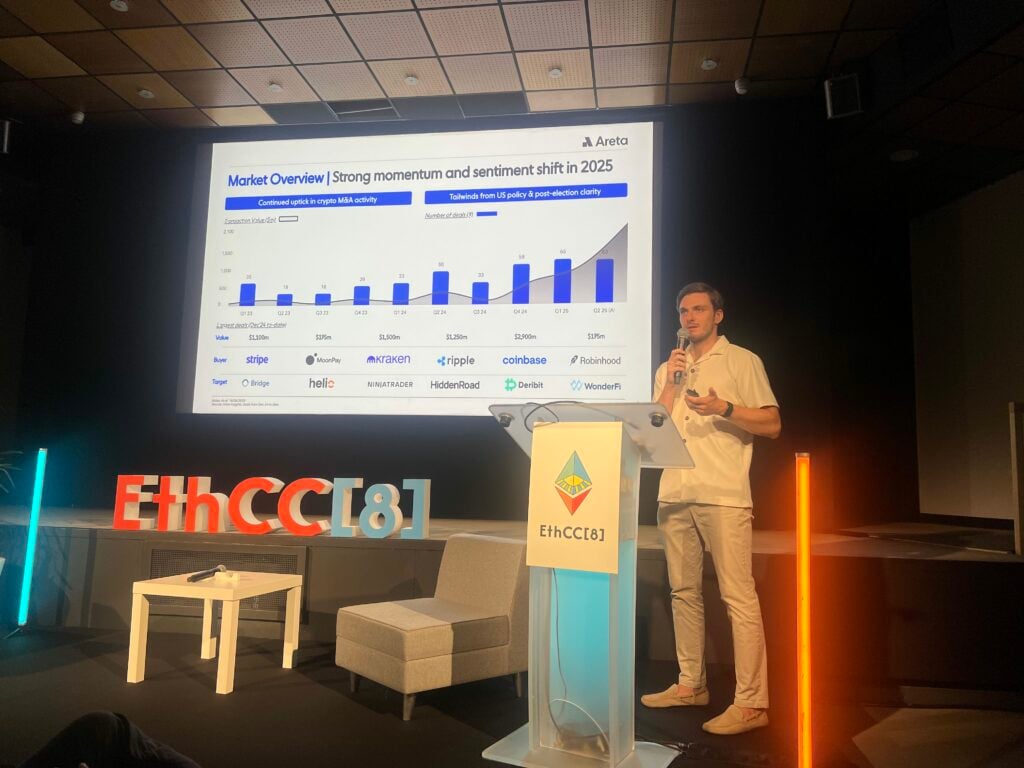Areta: Crypto M&A Smashes $40B in 2025 as Titans Clash for Dominance
Crypto’s consolidation wave just hit hyperdrive—mergers and acquisitions are eating the industry alive. Here’s why.
The land grab is on
With valuations swinging between absurd and opportunistic, deep-pocketed players are snapping up competitors faster than Bitcoin whales dump on leverage traders. Scale = survival now.
Speed wins, nostalgia loses
Legacy crypto firms clinging to 2021 playbooks are getting steamrolled. The new rule? Acquire or be acquired—no time for sentimental HODLing when deal flow moves at blockchain finality speed.
The $40 billion question
That’s the staggering price tag for this year’s M&A frenzy. TradFi bankers are ‘studying the trend’ (read: scrambling to justify their 2% advisory fees while crypto VCs lap them).
One thing’s clear: In the race for crypto supremacy, the finish line just got bought by someone else.

The four fronts driving crypto’s acquisition frenzy
The breakneck pace of crypto M&A isn’t accidental. Behind the 40+ billion-dollar deals of 2025 lie four strategic battlegrounds where acquirers are fighting for dominance:
Trading platforms have become prime targets, not for retail user bases, but for regulatory licenses and institutional infrastructure. When Robinhood acquired Bitstamp earlier this year, insiders saw it as a regulatory power play.
The acquisition gave Robinhood instant access to dozens of jurisdictions and a turnkey institutional trading desk. Similar moves by Coinbase and Swift reflect a new reality: compliance capabilities are now the competitive moat in crypto’s regulated future.
“You’ve seen Robinhood acquiring Bitstamp to increase their licensing footprint around the globe and also add institutional trading capabilities.” Karl-Martin Ahrend noted. Swift has acquired AZ crypto… to obviously consolidate user numbers and create significant synergies between the two businesses.”
The quiet consolidation in staking services tells another part of the story. As proof-of-stake networks now secure the majority of crypto’s value, control over validation operations has emerged as a strategic imperative.
Firms like Source Strategies are absorbing smaller validators, such as Solana-native players, to bring key operations in-house. The goal across the board is vertical control, faster deployment, and future-proofing in an increasingly competitive arena.
At the same time, payment processors are racing to own the entire stablecoin value chain, from issuance to settlement. Stripe’s acquisition of Preview and MoonPay’s European shopping spree reveal a clear pattern: companies are internalizing every step of crypto payments to capture this booming market.
With nearly 80% of crypto businesses now using stablecoins for B2B transactions, these moves represent bets on crypto’s future as a mainstream payment rail rather than just a speculative asset.
Perhaps the most radical development is unfolding transparently on blockchain ledgers themselves. The rise of token-based acquisitions, like Enzyme’s all-token purchase of Microfinance, shows how decentralized organizations are rewriting the M&A playbook.
But as Areta’s Jan-Philip Grabs noted during the presentation, “Unlike in more traditional M&A deals… you’re really lacking the clear framework and processes.” These on-chain mergers face unique challenges, from community governance hurdles to untested legal ground, yet they point toward a future where blockchain-native dealmaking becomes commonplace.

